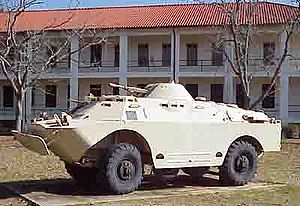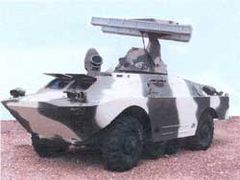This is an old revision of this page, as edited by Gon4z (talk | contribs) at 23:08, 31 May 2007 (Reverted to Sus scrofa version to remove vandalism by 212.200.177.203). The present address (URL) is a permanent link to this revision, which may differ significantly from the current revision.
Revision as of 23:08, 31 May 2007 by Gon4z (talk | contribs) (Reverted to Sus scrofa version to remove vandalism by 212.200.177.203)(diff) ← Previous revision | Latest revision (diff) | Newer revision → (diff) Weapon| BRDM-2 | |
|---|---|
 Iraqi BRDM at the U.S. National Infantry Museum, Fort Benning Iraqi BRDM at the U.S. National Infantry Museum, Fort Benning | |
| Specifications | |
| Mass | 7 tonnes |
| Length | 5.75 m |
| Width | 2.35 m |
| Height | 2.31 m |
| Crew | 4 (driver, co-driver, commander, gunner) |
| Armor | 14 mm |
| Main armament | 14.5mm KPVT machine gun |
| Secondary armament | 7.62mm PKT machine gun |
| Engine | GAZ-41 gasoline 140 hp (104 kW) |
| Power/weight | 20 hp/tonne |
| Suspension | Leaf springs with hydraulic shock absorbers |
| Operational range | 750 km |
| Maximum speed | 95 km/h |

The BRDM-2 (Boyevaya Razvedyvatelnaya Dozornaya Mashina, Боевая Разведывательная Дозорная Машина, literally "Combat Reconnaissance/Patrol Vehicle" †) is an armoured scout car used by Russia and the former Soviet Union. This vehicle, like many other Soviet designs, has been exported extensively and is in use in at least 45 countries. It was intended to replace the earlier BRDM-1 with a vehicle that had improved amphibious capabilities and better armament. The BRDM-2 is driven by a rear-mounted gasoline engine that also supplies power to a waterjet for amphibious travel. It has a crew of four, a driver, co-driver, commander, and gunner. The armament is the same as the BTR-60 armoured personnel carrier, a 14.5 mm KPV heavy machine gun with a 7.62 mm machine gun as a secondary weapon. The armor on the vehicle protects fully against small arms fire and artillery shell splinters.
It has two pairs of belly wheels and a centralized tire pressure regulation system for increased cross-country capability. It also has a single waterjet for propulsion through water. Externally, it differs from the BRDM due to its larger, box-like hull. It retains the boat-like bow of the BRDM. However, the crew compartment is now farther forward and the engine is in the rear. In the basic model, a small conical turret is mounted on the hull in a central position above the belly wheels. There are two front cupolas. Both sides have centrally placed vision blocks. The engine is larger than the BRDM's (it is a 140-hp V-8 instead of a 90-hp 6-cylinder). The BRDM-2 has an IR spotlight and IR driving lights, as well as an NBC filter system.
Capabilities
Like the BRDM, the BRDM-2 exists in several versions. The first four of these have the same roles as their BRDM counterparts.
The basic BRDM-2 reconnaissance vehicle is distinguished by its turret, which is the same as that mounted on the BTR-60PB. The conical turret, which mounts two machine guns (14.5-mm and 7.62-mm), is unusual in that it has no top hatch opening. This model carries a crew of four: the commander, the gunner, the driver, and the co-gunner. It also has a land navigation system that gives co-ordinate readings.
The BRDM-2rkh radiological-chemical reconnaissance vehicle has dispensers for emplacing warning flags around contaminated areas. Its primary armament is the 7.62-mm PKT instead of the 14.5-mm KPVT. The regimental chemical defence platoon and the divisional-level chemical defence company use it, as the does divisional reconnaissance battalion. The Soviet open press has designated it the BRDM-2rkhb; this stands for radiological-chemical-biological reconnaissance.
The BRDM-2U command vehicle has no turret; however, it carries a generator and extra radios. The increased number of antennas marks this version as a command and control vehicle. Battalion and regimental headquarters of maneuver and reconnaissance units employ it; artillery units also use it extensively.
The BRDM-2 ATGM launcher vehicle (sometimes referred to as the BRDM-3) can mount the AT-2 Swatter, AT-3 Sagger, or AT-5 Spandrel. The AT-5 launcher can also fire the AT-4 Spigot missile. THE STGM launcher replaces the turret. This model is found in regimental and divisional antitank units of MRDs, the antitank regiments of combined arms armies (CAA), and in the antitank regiment or brigade in the artillery division of a front.
The SA-9 Gaskin uses a variant on the BRDM-2 chassis. The SAM launching system with quadruple canister replaces the machine gun turret on top of the vehicle; it is capable of 360 degrees traverse and limited elevation. This version has a crew of three that consists of the commander, driver and gunner.
Poland's BRDM-2s have been fitted with a better engine and .50-calibre machine guns in place of the 14.5mm, had their retractable wheels removed, and a left side door added.
Limitations
Artillery fragments and a .50-calibre machine gun fire can penetrate BRDM-2 series vehicles with maximum armor of 14 millimeters. The BRDM-2-series tires are not protected by armour. They are particularly vulnerable to puncture from fire of all kinds.
Remarks
The original BRDM (also known as the BTR-40P) first appeared in 1959. The BRDM-2 (also known as the BTR-40PB) was first seen in 1966. It has generally replaced the BRDM in the Soviet and Warsaw Pact armies. The BRDM-2 is sometimes confused with the Hungarian FUG (OT-65) amphibious scout car and the FUG-70 APC, which have rear engines but also have twin waterjets. The BTR-60PB us replacing the BRDM-2 in divisional reconnaissance battalions .
Operators
 Albania - 30
Albania - 30 Angola
Angola Algeria
Algeria Armenia
Armenia Czech Republic
Czech Republic Eritrea
Eritrea Ethiopia - 250
Ethiopia - 250 Indonesia
Indonesia India
India Latvia
Latvia Lithuania
Lithuania Macedonia 10
Macedonia 10 Poland - 50
Poland - 50 Russia
Russia Ukraine
Ukraine
Former Operators
External links
- BRDM variants - Walk arounds and photos on Prime Portal
- fas.org
- BRDM-2 photo gallery at armoured.vif2.ru
- - Largest picture galery and overhaul of BRDM2 tanks
| Modern armoured fighting vehicles | |
|---|---|
| 4 × 4 | |
| 6 × 6 | |
| 8 × 8 | |
| 10 × 10 | |
| Tracked | |
| Soviet and Russian armoured fighting vehicles after World War II | |||||||||
|---|---|---|---|---|---|---|---|---|---|
| |||||||||
| |||||||||
| |||||||||
| |||||||||
| |||||||||